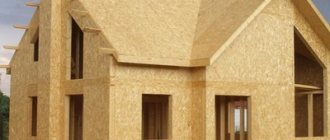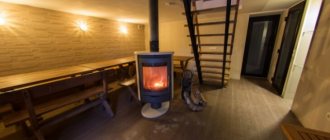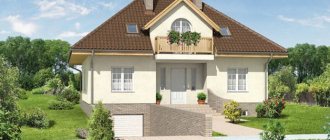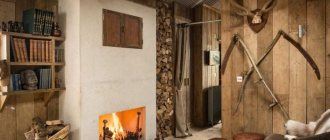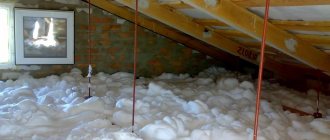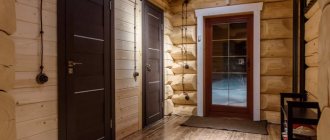- What is double beam
- What buildings are being built using this technology?
- Features of the technology
- Advantages and disadvantages
- 3 popular misconceptions about construction using double timber technology
Finnish double timber construction technology has been used in our country relatively recently, but is finding more and more adherents.
The popularity of the technique is explained simply - houses made of double timber are durable, environmentally friendly and warm. At the same time, they surpass traditional wooden buildings in terms of performance indicators. Such houses are designed for decades of impeccable service, look attractive, and meet all modern requirements for comfort, coziness and practicality. True, buildings also have disadvantages - for example, the difficulty of repairs when structural elements fail.
Our article contains the whole truth about double beam technology. You will find out what kind of houses are built using this method, what are its pros and cons, features and nuances.
What is a double beam?
The principle of building a house using this technology is to tie individual wooden blanks (thick boards or truncated beams) into a tenon, thereby forming a double-walled mirror structure. The cavity between the walls is then filled with sound, heat and vapor barrier materials, ensuring the maintenance of comfortable living conditions in the house.
The main task of the developers of this technology is to try to unify the construction process through the use of a prefabricated structure, the parameters of which would be selected taking into account the individual requirements of the customer.
At the same time, the latter could independently determine the required wall thickness, as well as select the appropriate insulating material (including the number of its layers).
Schematic design of a double timber house
Manufacturers of such structures intended to use mineral wool (ecowool) as a filler for inter-beam cavities. Polystyrene foam, penoplex or polyurethane foam can also be used.
Thanks to the versatility of this technology, you can build buildings of almost any profile, from a small cozy bathhouse to a permanent two-story house.
Communications: well and sewerage
During the production of the wall set, we laid communications.
A drilling company was invited to construct a well. In our area, the water lies at a depth of 25 meters. After drilling the well, the pump was lowered inside. Then, using an excavator, they dug a hole around the hole in the ground to install a reinforced concrete ring. A hatch with a cover was installed on top of the resulting structure. They laid a water pipe to the house. Spent 1 day.
The water well cost 48,000 rubles.
Specialists were also called in to install the sewer system using an excavator. The first step: we dug a trench from the point of entry into the house to the cesspool. Second step: we dug a hole 1.5×1.5×3 m to install reinforced concrete rings. Third step: installed reinforced concrete rings with a bottom on a concrete solution in the pit. Fourth step: coated all seams with bitumen mastic, installed a hatch with a cover. A HDPE sewer pipe was laid in a dug trench on a sand bed. A 20 cm layer of sand was poured over the pipe. Then everything was covered with soil remaining after digging the trench and hole (3 cubic meters).
We spent 1 day and 23,800 rubles on sewer installation.
Communication costs RUB 71,800.
Benefits of technology
The advantages of the “double beam” technology include:
- versatility, you can choose the composition and type of protective layer at your discretion;
- excellent thermal insulation characteristics. In terms of thermal insulation, a double wall is equivalent to a 40 cm thick timber structure. Have you ever seen such a wall? No? I didn't see it either.
- since mineral components are used as insulation, such timber is fire resistant (does not propagate combustion);
This is, frankly, a weak advantage. Adding mineral wool will not make a house comparable in fire resistance to a concrete one. However, residents may have a couple more minutes to leave the premises.
- due to the design features, material consumption is reduced, and the lightness of the walls will allow you to save on a lightweight version of the foundation;
- with this method of home improvement, you can do without additional finishing of its walls (both external and internal);
- the absence of any chemical components (adhesive compositions, in particular) significantly increases the environmental friendliness of the structure.
Strictly speaking, double timber does not belong to the category of materials from which you should build with your own hands. For this material, it is better to find a supplier who will make all the necessary parts from dried material with furniture-quality fitting. The buyer will only have to assemble the product on the site.
Assembly in progress: the main thing is to do it before the rain
If you decide to build it yourself, before starting construction work, the prepared material should be thoroughly dried, which will protect it from deformation and cracking. Only after this can you begin the actual assembly of the structure. Double timber is more sensitive to cracks than solid or glued timber.
As a cavity-filling thermal insulation material, I advise you to choose an environmentally friendly filler - ecowool, produced on the basis of natural cellulose. Among other things, this material is resistant to fire and absorbs extraneous noise well. In addition, it reliably protects structural elements from fungi, mold, rodents and other destructive factors.
If you use ecowool, you can do without special vapor barrier protection.
The only obstacle between you and ecowool may be the lack of suppliers in the region. In this case, mineral wool is also suitable; you can purchase and install it yourself. If possible, choose mats with a high density and be sure to use fixing fittings. Polyurethane foam is also suitable in terms of characteristics, but many experts have a strong prejudice about its compatibility with wood: the fact is that it does not “breathe” and can cause wood to rot if there is residual moisture in it.
Types of insulation
Mineral wool. The material has good air exchange, which in turn is ideal for “breathable” wooden buildings. This type of wool is fire resistant, has a long service life, and is resistant to chemicals. Disadvantages include the need for waterproofing, or the use of special compounds with hydrophobic properties. The environmental friendliness of such cotton wool is also still a matter of debate.
Styrofoam. An environmentally friendly material, which also has almost no shelf life. At the same time, it is lightweight, extremely cheap and has excellent insulating properties. However, it does not allow air to pass through, which is a disadvantage. The susceptibility to rodent attacks can also be considered a minus.
Expanded polystyrene. Some call this material foam, but in reality it is not. Expanded polystyrene is stronger, has more weight, but at the same time allows water, air and sounds to pass through better due to the larger number of voids. At the same time, it retains heat several times better than polystyrene foam.
Ecowool. Produced from pulp industry waste. The composition does not contain poisonous or toxic substances. However, the ideal fire retardant in its composition is borax, but the same boric acid is less preferable due to its not very pleasant odor and the decline in fire-fighting properties over time. In addition, special equipment is required to spray this cotton wool.
Important! Various types of insulation are very susceptible to high humidity, losing their properties under its influence. In this regard, laying insulation should be done only in dry and warm weather.
Disadvantages of double timber
Along with positive assessments of this product, a number of users also have certain doubts about its operation, expressed in the following:
- since the material, new to Russian conditions, has not yet passed the testing stage, there is still no complete confidence that all its characteristics correspond to the declared indicators;
In Russia, other methods of building a house from wood are still widespread (using profiled timber, for example).
- many users have doubts about the insulating layer, which, according to reviews, is prone to shrinkage with the loss of all the thermal insulation properties declared by the manufacturer;
Another difficulty is that it is difficult to control the condition of the internal cavities of the walls. Is moisture getting in there? Has rotting or mold started to form there? Are there any uninvited tenants there?
- uncertainty regarding the issue of repairing double beams. Of course, as a last resort, you can always turn to specialists, but this call will cost you a lot of money. You can't patch up a house like this on your own with jacks.
The specifics of the double timber structure require a special approach to organizing its production, ensuring unique operational parameters.
Projects and their implementation
Houses made of double timber are designed and installed by companies that specialize in this type of construction. To reduce the cost of the estimate, you can purchase a standard project adapted to your area and, if desired, make minor changes to it. Individual drawings are drawn up based on site research, but the price of such work will be much higher. Construction companies offering their services provide a package of services, which includes:
- creating a sketch;
- development of a draft working scheme;
- production of a set of parts;
- installation work.
At the first stage, the construction technology involves drawing up an architectural plan, drawing a diagram of the house, and outlining the main work. The most important and complex process is the production of the installation kit, from which the structure will be erected, and it is also the most lengthy – it takes up to a month.
The connection of structural elements occurs according to the locking principle. The construction process here is similar to the installation of a formwork structure, and the internal and external walls are erected simultaneously.
The main work, as in any other construction, begins with laying the foundation - in our case, a shallow strip foundation is suitable, but if for some reason it is not possible to install it, they resort to a screw foundation. In general, the installation work plan looks like this:
- pouring the foundation;
- walling;
- waterproofing and strengthening;
- façade finishing.
Assembling a house is somewhat reminiscent of a construction set, because here one part of the element is equipped with a tenon, and the other with a groove, which, when connected, form a strong connection without gaps. The first level is laid on a base of slats, and the gaps between the boards are filled with foam. Particular attention must be paid to the joining of parts in the corners, for which the material is profiled.
Simultaneously with the construction of the walls, insulation is laid, but only in dry weather. The technology of building houses from double timber does not allow the process to continue during precipitation, due to which the material becomes wet and loses its properties.
List of works
A standard package of work usually includes the construction of load-bearing elements, internal partitions, installation of floors and a rafter system. The estimate also includes the installation of a screw foundation and plastic window systems. A team of craftsmen also performs roofing work.
When placing a more expensive turnkey order, professionals will install communications, and the quality of such work will be at a high level, plus they are guaranteed. You can choose the most optimal set of services for yourself, which you will inform the construction company at the time of drawing up the contract.
Thermal insulation work
Disputes continue over the advisability of installing a vapor barrier membrane, during which some experts insist on its installation, while the other half insist that such manipulations will disrupt the natural circulation of air, which will lead to mold and fungal infections between the beams. Some construction technologies imply vapor barriers exclusively in the ceilings, and the remaining areas of the house are insulated at the discretion of the owners.
Based on practical observations, we can say with confidence that the slab material does not give the same effect as ecowool, because the slabs deform during installation and generally over time, which is why heat losses increase significantly. Ecowool is blown into the wall without tamping in several stages, which allows the material to gain the required density naturally.
A similar process must be carried out at a temperature with a plus sign, since in frosty weather it is difficult to calculate the required amount of insulation, and its excess can lead to deformation of the walls, and if there is a lack of ecowool, the thermal insulation of the house will not reach the required parameters.
To save money, instead of ecowool, they often purchase basalt fibrous material, which has similar properties, but requires vapor barrier protection , otherwise it will not be possible to avoid the appearance of condensation, which provokes the formation of fungal and mold infections. If this process is started, it can lead to the destruction of the house because the wooden elements will rot and collapse.
Considering all these nuances, it becomes obvious that the savings are questionable, because vapor barrier disrupts healthy air circulation in the room, wood does not breathe, making it impossible to regulate humidity.
Also, some developers fill the space between the beams with a mixture of clay and straw or polystyrene foam granules. There are also those who do not install thermal insulation at all, citing the fact that this function is performed by an air cushion between the walls. Perhaps there is a rational grain in this, but if you are building a bathhouse or sauna using this construction technology, you cannot do without insulating material, and houses made of double timber will consume less energy for heating residential premises if the partition is additionally insulated.
Design features
When you carefully study the “double beam” technology, you will immediately notice some features of its implementation related to the design of prefabricated elements. First of all, what is striking is that it is based on a system reminiscent in its structure of standard sandwich panels. In this case, the wooden sidewalls of the frame base mirror each other, and insulation in one or several layers is placed between them (selected depending on the region of residence).
Hidden communications can be laid
The thickness of the timber sidewalls usually does not exceed 70 mm, but you can choose this value at your discretion (it should also be tied to the climatic conditions in your area).
The versatility of this material is also manifested in the fact that using the “double timber” technology it is possible to erect buildings with a wall height of up to 10 meters and a thickness of up to 340 mm.
Exceeding the specified thickness is allowed, but there is no point in this, since in a building with such indicators, comfortable living conditions are provided by the wall structure itself
Communications: well and sewerage
During the production of the wall set, we laid communications.
A drilling company was invited to construct a well. In our area, the water lies at a depth of 25 meters. After drilling the well, the pump was lowered inside. Then, using an excavator, they dug a hole around the hole in the ground to install a reinforced concrete ring. A hatch with a cover was installed on top of the resulting structure. They laid a water pipe to the house. Spent 1 day.
The water well cost 48,000 rubles.
Specialists were also called in to install the sewer system using an excavator. The first step: we dug a trench from the point of entry into the house to the cesspool. Second step: we dug a hole 1.5×1.5×3 m to install reinforced concrete rings. Third step: installed reinforced concrete rings with a bottom on a concrete solution in the pit. Fourth step: coated all seams with bitumen mastic, installed a hatch with a cover. A HDPE sewer pipe was laid in a dug trench on a sand bed. A 20 cm layer of sand was poured over the pipe. Then everything was covered with soil remaining after digging the trench and hole (3 cubic meters).
We spent 1 day and 23,800 rubles on sewer installation.
Communication costs RUB 71,800.
Areas of use
Naturally, you may have a question about what else (besides residential buildings) is allowed to be built using the technology we are considering. The answer is the following list of its possible applications:
- construction of baths and similar health complexes;
- organization of recreation areas, including a barbecue with a gazebo;
- arrangement of modern children's playgrounds and sandboxes;
- production of wooden canopies in summer cottages;
- organization of parking spaces for vehicles;
- production of special furniture samples.
We will separately consider the nuances of producing blanks for this technology.
Ready-made “double” house
